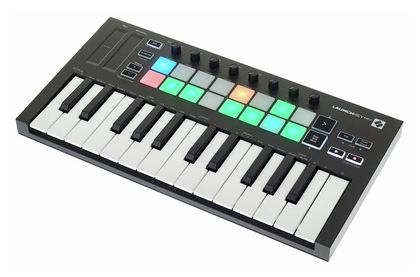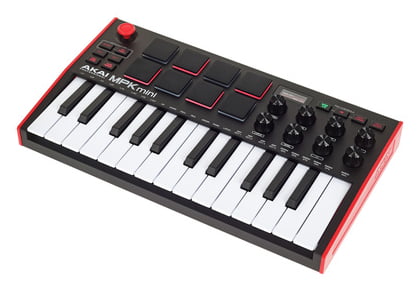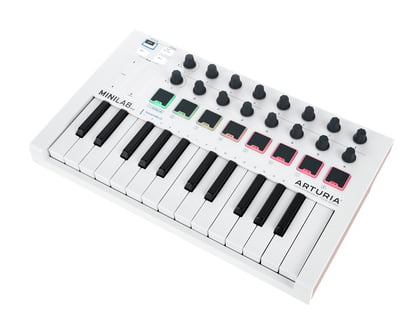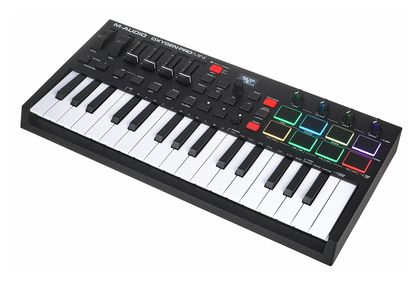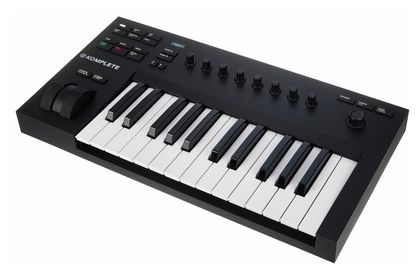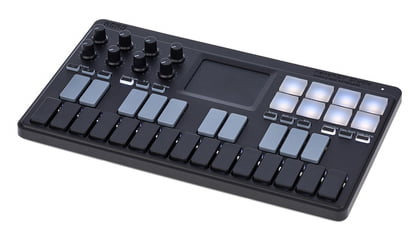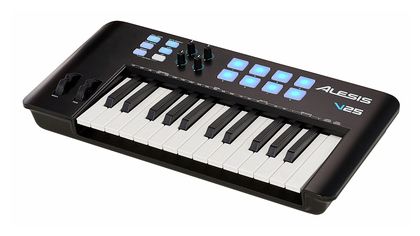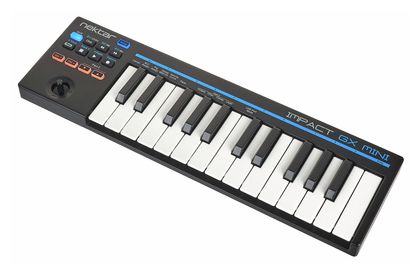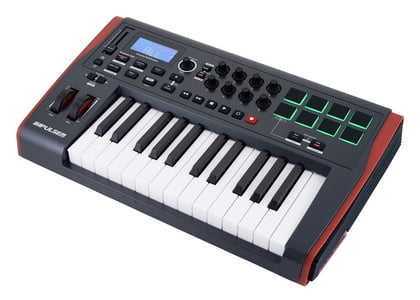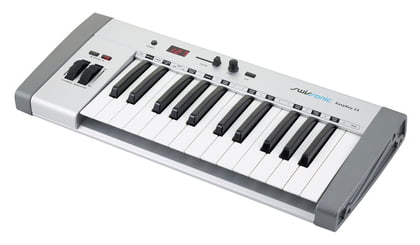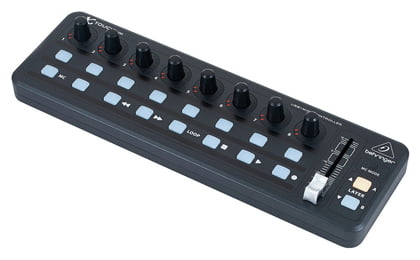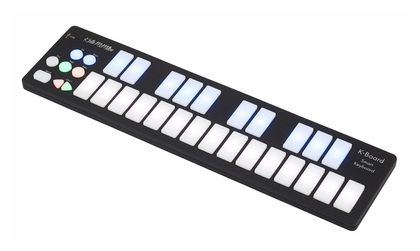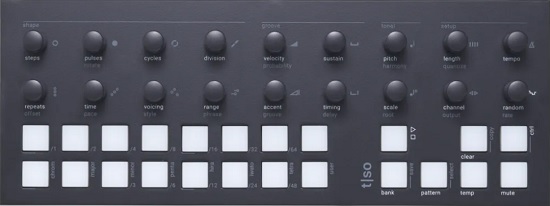If you’re struggling to work in a cramped workspace with bulky midi controllers and an annoying network of wires, today’s topic talks about the top 12 small MIDI keyboards & controllers to save some space. Judging by the criteria, you might have guessed that the list covers the more compact versions of the controllers discussed in some of our previous topics.
When it comes to the 25 key midi controllers, the competition is extremely high. Some renowned brands are in a constant struggle to offer the maximum number of features in the smallest possible packaging. However, after an in-depth look, you’ll find plenty of standard features that most of these midi controllers possess.
Nevertheless, even the most common features are managed better by some than others. It also takes an out-of-the-box approach to come up with something innovative to woo the target audience and get a leg up on the competition. This is where certain brands really come into their own.
By the end of our analysis, you’ll surely have decided what functions attract you the most so that you are well equipped to make the right decision regarding your next purchase. So join us now as we look at some of the more portable midi controllers that are small in stature but still pack a punch considering the features they offer.
Top 12 Small MIDI Keyboards To Save Space 2024
1. Novation Launchkey Mini MK3
The Mini MK3 is the tiniest member of the Launchkey family.
Novation’s Launchkey Mini may be small but has enough features to justify its existence. The controls spread across the top panel make good use of limited space by providing one touch buttons to trigger different effects. The drum pads on the MK3 provide a premium feel and have several modes.
The package includes a digital workstation and several plugins to assign sounds to your handy Launchkey Mini. The MK3 also has enough transport controls on its control panel to manage crucial features of your digital workstation while recording and mixing.
Key Features:
- Appearance
The Mini MK3 has 25 synth-action mini keys that are velocity sensitive. The unit weighs 0.7 kg and has dimensions of 12.9″ x 6.8″ x 1.2″. The back panel has a USB type B port to power the unit while connected to a computer and a midi out port for an external midi device.
The device comes with a type A to type B USB cable. There is also a port for the sustain pedal.
- Controls
The MK3 has pitch and modulation controls in the shape of touch strips. A shift button gives access to secondary features of some of the other buttons. A separate transpose button can change the keys of a song up to 11 semitones in either direction.
A pair of +/- buttons can change octaves of the keys. In addition, 8 multifunctional knobs can change software/hardware parameters. The unit also has an arpeggiator and a fixed chord button that allows playing chords with a single key.
- Drum Pads
The Novation Launchkey Mini MK3 has 16 velocity-sensitive pads with backlights. You can play drums or notes with the pads. Other customizations like triggering user-preferred sounds or changing the color of the backlights can also be done.
- DAW Controls
The Novation MK3 has some DAW controls on board. The drum pads can be used to trigger sounds on your digital workstation. There are a couple of transport buttons, including a record and play button, that perform the corresponding functions on your DAW.
You also get a button to toggle a track’s stop, solo, and mute functions. Finally, the> button can be used to launch scenes.
- Software
Registering the MK3 on the Novation website allows you to download the lite version of Ableton Live 10. The AAS session bundle includes three plugins that give you access to several virtual instruments, including grand pianos, electric pianos, synths, guitars, and organ sounds.
The bundle is also packed with effects to give you the sound you want.
Pros:
The Novation MK3 is extremely light and portable. Considering its size, the MK3 still has plenty of controls to navigate and operate your DAW. The drum pads are responsive and have different modes for different tasks.
The software bundle includes some useful plugins as well as Ableton Live Lite.
Cons:
Novation Launchkey Mini MK3’s keys do not have an aftertouch feature. A TRS adapter for the midi port would have been a good inclusion. The unit needs to be powered externally when used with IOS devices.
The size of the drum pads is very small which makes hitting individual pads with multiple fingers a challenging.
2. AKAI Professional MPK Mini MK3
The simple-to-use MPK Mini MK3 from Akai is feature-rich yet saves space.
The build quality of the instrument is quite good. Much like other midi controllers that Akai produces, the pads on the MPK Mini are well made and have a professional feel. In addition, the different modes and features make them fun to experiment with.
The MPK Mini has some customizable controls that can be assigned to perform different functions on the keyboard itself and third-party digital audio workstations. In addition, Akai’s own MPK Mini Editor software can be used to access more assignable options related to the MPK Mini MK3.
Key Features:
- Appearance
The MPK Mini MK3 has 25 synth-action mini keys with velocity sensitivity. Weighing around 0.75 kg, the MPK Mini has dimensions of 12.5” x 7.13” x 1.75”. The back panel only has an input for a sustain pedal and a USB type B port, which powers the unit with the help of the included USB cable.
- General Controls
Akai’s MPK Mini has a pair of octave buttons that can assign up to 10 different octaves to the 25 available keys. In addition, a 4-way joystick can be used to perform the pitch bend feature. The MPK Mini MK3 also has 8 270-degree rotation knobs that can change different parameters.
- Drum Pads
There are 8 velocity-sensitive drum pads that can be used to trigger notes or drums. The pads can also be used to trigger sounds on your DAW. The pads are arranged in two banks (A/B), so in essence, the unit has 16 pads in total.
A CC and program change buttons can determine whether the pads send out midi CC or midi program change information. The full level activates maximum velocity on the pads regardless of how light they’re played. The pads also have a note repeat feature.
- Arpeggiator
The unit also has an arpeggiator toggle button and a tap tempo button to set the tempo of the arpeggiator. Holding down the arpeggiator button and pressing keys on the keyboard will activate different functions associated with the arpeggiator like its timing, order of notes played, latch feature, randomizing notes, and changing octaves. Swing can also be added to the arpeggiator here.
- Software Bundle
The MPK Mini MK3 comes with MCP beats and several virtual instruments, including Tubesynth, Hybrid 3, Electric, Mini Gran, Velvet, and Bassline. So, in one package, you get drums and percussion loops, acoustic and electric piano sounds, synth sound libraries, and bass guitar simulations to get you going instantly.
Pros:
The software bundle has all the beats and sound libraries you need to begin recording and mixing your music. The arpeggiator is very versatile and has detailed features like latch, randomizing notes, swing, and much more. The drum pads provide a great touch response and are customizable.
Cons:
The keys are a bit stiff. Also, due to the smallish size, the keys may sometimes be a challenge to play. The transpose feature is a bit buggy on this unit. The software accompanied by the unit requires some specific codecs, and the installation takes some doing. There is no midi out on the back panel.
3. Arturia MiniLab Mk II
The MiniLab and MicroLab lines feature the most compactly sized controllers offered by Arturia.
The MiniLab MK II is a little unit that saves your studio space while offering a nice range of intuitive controls that effortlessly change parameters on your DAW and virtual instrument plugins. As with most controllers, you can do a good deal of customization and assign different functions to the onboard controls.
Arturia’s MK II’s weight and strong build give the feel of a much more expensive product. The software bundle includes Arturia’s own plugin that provides a wide variety of virtual instrument sounds to map on your MK II including guitars, pianos, synths, organs, and much more.
Key Features:
- Appearance
The Arturia MiniLab MK II has 25 slim keys with synth action. Sized at 14” x 8.7” x 2”, the MK II weighs 1.5 kg which is a bit heavier than the midi controllers discussed so far. The input options on the back include a port for the sustain pedal and a USB type B port that powers the unit. In addition, the MK II comes with a USB cable.
- Controls
The MiniLab MK II has two touch strip pitch and modulation controls. Two buttons on the top of the touch strips can change up to 4 octaves on the keys or bring the keys back to the default octave. Pressing the shift button gives access to dual functions like combining with the MK II’s keys to select midi channels, among other things.
- Drum Pads
The MiniLab has 8 pressure-sensitive drum pads. The pads can be used to trigger drums or note patterns. A button labeled Pads 1-8/9-16 allows you to access the second bank of 8 pads, giving you a total of 16 pads on the unit.
When integrated with a DAW, the first 8 pads trigger sounds while the remaining 8 pads perform different software features. Using the shift button and pressing the pads will load up to 8 saved presets.
- Encoders
There are 16 encoders on the MiniLab MK II’s interface. The first 8 encoders can be clicked to reveal certain adjustments that can be made to the saved presets. All 16 encoders are customizable and can change different parameters on the DAW or plugin.
- Software
Registering the device can give access to Ableton Live Lite, the DAW included with the MiniLab MKII. You can also download Arturia’s own Analog Lab Light, which provides a rich library of piano sounds that can be easily implemented on the MK II, thanks to the user-friendly interface.
In addition, the Grand Piano plugin by UVI gives access to some high-end acoustic piano sounds.
Pros:
The clickable feature of the first 8 encoders makes it easy to change the saved presets. Analog Lab Lite is a great app and helps you get going even if you have little familiarity with the interface. The unit has a nice weight to it and exceeds in quality compared to some of the competition.
Cons:
The USB port is quite flimsy and can be damaged with little force. The customizable knobs don’t work perfectly well with some DAW. The knobs may turn on and off at will or get reassigned automatically. Some of the links to register the product are outdated and need to be fixed.
4. M-Audio Oxygen Pro Mini
M-Audio’s Oxygen Pro Mini is slightly bigger than most 25-key mini controllers.
The Oxygen Pro Mini has been designed so that you can select from a list of popular DAWs, and the unit’s assignable knobs, faders, and pads automatically map to various objects on the DAW. The user can also edit these presets and assign tasks according to preference.
The build quality of this midi controller is impressive. The unit’s size remains portable while boasting popular options and controls. The display is small but precise and effectively lets the user know the selected feature and its parameters at a glance.
Key Features:
- Appearance
The M-Audio Oxygen Pro Mini is slightly bigger than the other controllers discussed so far, with 32 velocity-sensitive, semi-weighted keys. The instrument has dimensions of 15.8” x 7.52” x 2.56” and weighs almost 1.2 kg. The Pro Mini is bus powered through its USB type B port (USB cable included) and has a midi out port and an input for a sustain pedal.
- Controls
The Oxygen Pro has two wheel controls for the pitch bend and modulation features. A pair of up and down buttons to go up to 3 octaves above or below the default setting. A DAW/Preset button can be used to map the controls according to a digital workstation or the presets on a virtual instrument.
The unit also has an arpeggiator with a latch feature and options to change the tempo. Chords can be played using single keys, and the keys can also be restricted to play a specific scale.
- PADs
The Oxygen Pro has 8 pads that are velocity sensitive and have backlights. The pads also have a note repeat feature which makes for some interesting sounds. The select/scroll encoder can be used to set the timing of the note repeat function.
- DAW Controls
Pressing the DAW/Preset button switches on the DAW mode. Now 4 knobs and 4 faders can help control different aspects of the DAW. The drum pads are also programmable and can help make changes in DAW mode.
Further transport controls include record, stop, play, rewind (<<), and forward (>>) buttons. The <</>> buttons can also move up and down the DAW instance. Loop and tempo buttons can also be used in DAW mode.
- Software Bundle
The digital audio workstation included with the Oxygen Pro is the lite version of Ableton Live. The Oxygen Pro also comes with Air Music Tech Virtual Instruments, which include TubeSynth, Velvet, Mini Grand, Bassline, Electric, and Hybrid 3, so you have all the virtual sound samples you need to start producing music.
Pros:
The Oxygen Pro has standard pitch and mod wheels rather than touch strips, making quick access accurate and easy. You also get a midi output which some midi controls this size do away with. The select/scroll encoder is intuitive and makes navigating through and selecting features convenient.
Cons:
The midi controller’s DAW integration claims are a bit questionable. Most of the map-able controls do not work as smoothly as advertised. In addition, the drum pads are slightly unresponsive, becoming unreliable with quick taps. A TRS adapter could have been included.
5. Native Instruments Komplete Kontrol A25
The rugged build of Native Instrument’s Komplete Kontrol A25 is impressive.
The Kontrol A25 is easy to integrate with all major DAWs. Moreover, the unit allows a good range of customizable controls that can map seamlessly to a compatible DAW or be assigned according to user preference just as easily. The inclusion of Komplete Kontrol helps to organize your virtual instrument libraries efficiently.
The touch-sensitive knobs can manage to change the parameters of several top instrument plugins quite effectively. Furthermore, some single button features take care of some crucial features offered by the Komplet Kontrol A25, which provides a pleasant user experience.
Key Features:
- Appearance
The NI Komplete Kontrol A25 has 25 semi-weighted, velocity-sensitive keys. The unit has dimensions of 19.2” x 10.1” x 3.5” and weighs 2.4 kg.
There are just two ports on the back panel of the Komplete Kontrol, one of which is the USB Type B port that can be used to connect to the computer and powers the unit through bus power. The only pedal input can accommodate a sustain pedal.
- Controls
The A25 has a pitch wheel and an assignable modulation wheel. The unit also has octave change capabilities and an arpeggiator. Dedicated buttons can help map preferred scales over the available keys or change the key of any song being played. In addition, the unit has a small two-row display that shows relevant settings according to the selected feature.
- Transport Controls
A separate transport controls section includes record, stop, and play buttons and a tap tempo button to set the metronome in your DAW. You can also use a loop button to continuously play an audio section in the DAW. The digital workstation can be navigated using the 4-way control knob with ease.
The browser, plugin, and track instance buttons let you dig deep into the DAW instance and plugin libraries to find the sound you need.
- Software Bundle
The software bundle gives a unique combination of synth and piano sounds. Monarch and Reaktor Prism provide innovative synth capabilities through their power synth engine. Gentleman and Scarbee 1 have you covered if you’re a piano player who likes to explore acoustic and electric piano sounds.
And if you’re done exploring all these, you get a voucher to access additional instruments and effects.
- Komplete Kontrol
Another software worth mentioning here is NI’s Komplete Kontrol which combines all your virtual instrument libraries from installed plugins and organizes them under relevant categories.
In addition, the search feature can pull up required options, which can then be selected and used after hearing a preview. This way, the workflow gets streamlined, saving a lot of time.
Pros:
The software bundle has some powerful plugins that provide vast libraries of pianos and synths. In addition, there are plenty of transport controls to achieve a suitable level of operation concerning the DAW. The knobs on the unit are touch sensitive and show assigned parameters on the A25’s display which is a handy feature.
Cons:
The A25 lacks a Midi out port. A bigger display would have enhanced the user experience as the two-row screen is extremely tiny and not very user-friendly. Furthermore, the display may develop screen fade/burn issues with time. In addition, the quality of the keys on the Komplete Kontrol could be improved.
6. Korg nanoKEY Studio
The Korg nanoKey Studio is the most unique-looking controller on the list.
Rather than having the more familiar synth action or semi-weighted keys, the nanoKey, as the name suggests, has keypads. The unit is sleek in design but has all the goodies under the hood that you would expect from some more conventional-looking devices.
Korg has also given this controller’s key features a very innovative spin. At first glance, you may think of this one as a computer keyboard as it has an unfamiliar touchpad. However, this out-of-the-box approach from Korg enhances the nanoKey’s functionality rather than hindering it.
Key Features:
- Appearance
The keys on the Korg nanoKEY Studio are very different from the controllers discussed so far. On the controller, you find 25 keypads that are velocity sensitive. The instrument is sized at 10.9″ x 6.3″ x 1.3″ and weighs less than 0.5 kg. The nanoKey has a USB midi output.
- Connectivity
The nanoKey Studio can connect to a computer via the micro-USB type B port on its side. However, that is not the only way to do so. The controller also has Bluetooth, so wirelessly connecting a computer or a mobile device can also be done. The device is bus powered but also works with 2 AAA batteries.
- X/Y Pad & Sustain
The pitch and modulation functions are uniquely implemented on the Korg nanoKey Studio through an X/Y touchpad. Moving a finger up on the touchpad will affect modulation features, while moving it on the X axis will change the pitch.
In addition, instead of a sustain pedal output, the controller has a sustain button that can be pressed to sustain a note even beyond key release.
- Other Controls
Multifunction octave shift buttons can map the keys 4 octaves higher or lower than the default setting and perform transpose functions. The easy scale button can apply a scale on the keys according to the selected key.
The keys have scale guide lights to let the user know the scale notes. The nanoKey Studio also has 8 assignable knobs and drum pads. You can also assign and play a chord with a single pad. The nanoKey also has an arpeggiator.
- Korg Gadget
The nanoKey Studio comes with music software for apple devices. The instrument also comes with Korg Gadget special edition, which offers over 40 virtual instrument sounds, including drums, acoustics, synthesizers, pianos, and many others.
The Bundle also includes Collection M1 LE, which brings classic Korg instrument sounds to your controller.
Pros:
Using the touchpad for pitch and modulation changes can be a fun experience. The X/Y pad also helps music creation as you can easily play random notes on a scale by sliding over it. Bluetooth connectivity saves you from wires snaking around your workspace.
The controller is extremely portable due to its size.
Cons:
The nanoKey Studio has Bluetooth connectivity issues with IOS 13 and Windows 7 operating systems. Korg’s customer support is slow, and your issues may sometimes not get resolved.
The drum pads lack the appropriate response for fast-touch music. The keys are actually pads which may not suit everyone.
7. Alesis V25 MKII
Alesis has three different controls in the 25 key range.
The Alesis VI25 is the fully featured edition, while the V25 and V25 MKII are the lower-end versions in terms of price. However, the Alesis V25 MKII provides all the basic features, regardless of its compact and simple appearance. In addition, the downloadable MK II editor helps to fine-tune the controls on the Alesis V25 MKII with relative ease.
All the major controls are laid out nicely on the front panel, and Alesis has smartly assigned different functions to the multipurpose keys on the unit to save space and improve the workflow. In addition, the keys on this controller are nicely sized and made from good quality material to provide a premium feel.
Key Features:
- Appearance
There are 25 velocity-sensitive synth-action keys on the Alesis V25 MKII. The unit has dimensions of 16.92” x 9.6” x 3.72” and weighs 1.8 kg. Connecting the controller to a computer can power it via the USB type B port with the help of the included USB cable. The back panel has an on/off button and an input for a sustain pedal.
- Controls
Alesis V25 MKII has pitch and modulation wheel controls to the left of the keys. The unit also possesses octave buttons, an arpeggiator button, and a button to set the tempo of the arpeggiator. The arpeggiator also has a latch and swing features. In addition, 4 assignable knobs on the unit can help control parameters on a DAW or plugin.
- Drum Pads
The Alesis V25 MKII has 8 pressure-sensitive drum pads with backlights. The pads can be used to generate beats/notes and can also perform other assigned functions. For example, the full-level feature sets all the pads to be played at maximum velocity (127) regardless of how hard they are hit.
Another handy feature is note repeat, which re-triggers the previous note played at the current tempo settings.
- Key Controls
Several features labeled over the keys can also be adjusted. These include time division changes ranging from 1/4th of a note to 1/32 note triplet. How the arpeggiator notes behave can also be selected from options like up, down, inclusive, exclusive, order, and random.
Arp octaves, latch feature, and sync on/off can also be adjusted through the key controls.
- Software Bundle
The Alesis V25 MKII comes with MPC beats which provide drum and percussion libraries for you to get familiar with the pressure-sensitive drum pads.
In addition, the downloadable MKII editor software can help assign functions to the control knobs, and the V25 also comes with 60 Melodics lessons to enhance your skills, making you sound like a pro in no time.
Pros:
The 60 lessons from Melodics are of great value if you are just getting started with midi controllers and want to learn and improve your keyboard playing. You can dig deep into the countless arpeggiator functions and get creative with your sound. The keys feel great.
Cons:
The controller is a bit bulky compared to the other midi controllers on the list. The build quality of the ports is a bit flimsy. The USB port is quite delicate. The links for downloading relevant software are outdated, and the customer support lacks a timely response for quick problem-solving.
8. Nektar Impact GX Mini
Nektar has some worthy offerings in the 25 key midi controller category.
Out of the three contenders, namely the GX Mini, LX Mini, and Nektar SE25, the GX Mini stands in the middle in terms of price. However, the midi keyboard offers sufficient transport controls to adequately control your digital workstation and plugins.
The control layout seems nice and uncluttered. The Impact GX Mini’s sleek and narrow design makes it a good tool to keep in your backpack for composing songs when sudden inspiration hits you. In addition, the pitch and modulation controls on the unit have been nicely handled, making the player sound even more expressive.
Key Features:
- Appearance
The Nektar Impact has 25 mini keys, which are velocity sensitive. The GX Mini weighs almost 0.5 kg and has dimensions of 15.35” x 4.52” x 1.25”. The instrument has a micro-USB port that can be used to connect it to a computer and draws power from the USB port. There is also an input for a pedal.
- Controls
The GX Mini has a four-way joystick that controls pitch and modulation features. The octave of the keys can also be changed with up and down buttons. You can also layer your sounds or use a transpose feature to quickly change the key of a song as you play.
- Part 2 Controls
Pressing the 2 buttons under the part 2 section can activate some key functions labeled over the keys. These features include octave changes, transpose features, and layering notes. The sensitivity of the keys can also be set here. There are three velocity presets to choose from.
- DAW Integration
A transport section has buttons that can be used to control the DAW, including record, stop play, rewind, and forward buttons. You can also set the tempo of the tracks in the digital workstation and loop your sounds.
Using shift with these buttons will access their second functions, which can help change tracks, open plugin windows, and undo previous changes, among other things.
- Software
The Nektar Impact GX Mini is compatible with all famous DAWs, including Reaper, Fruity Loops, Garageband, Logic, Reason, Studio One, and more. The controller also comes with Bitwig 8-Track, which has over 50 virtual instrument sounds and integrates easily with third-party plugins.
Pros:
The pitch and modulation joystick feel great. The Impact GX Mini has a reasonable number of DAW controls to operate popular DAWs effectively. In addition, the Part 2 controls can temporarily trigger features like octaves/transposition until the buttons are released, which has some useful applications.
Cons:
The keys on the Impact GX Mini disappoint in more ways than one. The quality is quite poor, and the pressure sensitivity of random keys decreases with time. There is no midi output. The unit malfunctions when integrated with Ableton Live.
9. Novation Impulse 25
Novation Impulse has packed some unique features in its Impulse 25.
The instrument provides several customizable options in the form of assignable controls so that you can streamline your workflow and make it efficient. Some key features are kept on easy one-touch buttons for quick access on the go. In addition, a help section offers support if you don’t have the manual nearby.
The Impulse 25 has a good-sized display to show you where you are at a glance. In addition, some DAW-friendly controls allow you to access major functions of the digital workstation straight from the controller itself. The software includes a DAW and some useful plugins to get you started.
Key Features:
- Appearance
The midi controller has 25 semi-weighted keys which is a great feature for a controller this size. The keys are also velocity-sensitive. The unit is sized at 20.67” x 13.07” x 3.94” and weighs about 3.5 Kg.
You can connect a sustain and expression pedal to the device, offering midi input/output ports. A USB type B port provides bus power and computer connectivity.
- Controls
The controls include modulation and pitch wheels. You get octave change and transpose options on the Impulse 25. There is a speed adjustable arpeggiator on board as well. In addition, you can split the keys into different zones. The velocity sensitivity of the keys is adjustable, and an aftertouch feature can also be enabled.
- Assignable Options
The 8 speed sensitive knobs can control different parameters in a DAW or plugin environment. The drum pads available on the Impulse 25 can also be assigned different tasks. Similarly, the volume fader on the unit can be used to control levels in a digital workstation.
The behavior of these assignable controls can be managed through a separate control button.
- Help Section
Pressing the +/- buttons simultaneously opens a help section that provides useful information that can be scrolled through on the display to get a brief overview of what each function does. These buttons are multi-functional and can also be used to scroll through features.
- Software
The Novation Impulse 25 comes with the lite version of Ableton Live. The software bundle also includes Bass Station by Novation, equipped with high-end synth sounds. The Loopmasters Sample Library provides a wide array of looped drums and music tracks to work with.
In addition, Mike the Drummer gives access to percussion sounds from different genres and playing styles.
Pros:
The software bundle saves a lot of money as you don’t need to invest in a DAW or plugins to get decent sounds from your controller. The customizable knobs and pads can enhance the user experience when working on digital workstations or plugins. The overall build quality is quite impressive.
Cons:
Software integration isn’t always smooth and bug-free. The device may act up when used with Cubase, Pro Tools, or Logic. The software behind the customizable knobs and controls is also a bit unreliable, due to which some may not respond as they should.
10. Swissonic EasyKey 25
The EasyKey series comes in 25, 49, and 61 key variants.
The Swissonic EasyKey 25 is a rather simple-looking unit compared to the complicated front panels of some of the other controllers in the 25 keys category. As a result, you don’t see a lot of customizable knobs or faders that we have become so accustomed to seeing with time.
The controller has a nice weight to it and is built like a tank. There are some useful input and output options on the back, and all the standard features are there. Apart from performing their regular task, the keys are capable of handling other responsibilities when the edit mode is triggered.
Key Features:
- Appearance
The Swissonic EasyKey has 25 full-sized keys that are also velocity-sensitive. However, the keys do not have aftertouch. The unit weighs around 2.8 kg and has of 19.5” x 8.2” x 2”. The EasyKey has a rugged body made of aluminum with plastic on the sides.
- Input/Output
Regarding connectivity options, the back panel of the EasyKey 25 has a midi output to connect to sound modules and a port to connect an expression pedal. A USB type B port is also on the back to connect to a computer and power the unit. A USB cable is included in the box.
- Controls
The EasyKey 25 has pitch and modulation wheel controls on the left of the keys for quick access. The top panel has a power button next to a small display that shows the value of patches and different parameters. Two-octave buttons can assign different octaves to the keys and transpose the keys of different songs.
- Programmable Options
The Swissonic EasyKey 25 has a dual feature fader to control the unit’s volume and change different values in a plug/DAW. There is also a programmable encoder that can be assigned any parameter from the edit mode as per user preference.
- Key Controls
The keys of the EasyKey 25 can perform several functions in the edit mode. Some of these include program selection, resetting values, channel selection, loading and storing presets, and many others. You can also set the velocity sensitivity of the keys here.
Pros:
The keys are full-sized, and the response is good. The unit is very strongly built. Swissonic has made good use of the keys by assigning them dual functions to change the behavior of controls on the front panel and inputs/outputs on the back. An option of a midi out on the back is handy for connecting to sound systems or other midi devices.
Cons:
The Swissonic EasyKey 25 has no aftertouch feature. Compared to the other midi controllers on the list, the EasyKey is far behind in customizable DAW controls. You only get one assignable fader, a single encoder, and the unit lacks transport control. Also, there are no drum pads on the EasyKey 25.
11. Behringer X-TOUCH MINI
The X-Touch Mini is substantially different from the rest of the controllers listed here.
Instead of being a midi controller that has semi-weighted or synth-action keys and drum pads to manage your favorite sounds and compose music for your ongoing productions, the X-Touch Mini has a different agenda. All you see on the front panel are a bunch of knobs, soft buttons, and a fader.
The absence of a key bed makes the controller extremely compact and demands very low power. Behringer has designed the X-Touch to be solely a DAW or plugin controller with layering options to get the most out of the controls on the user interface.
Key Features:
- Appearance
Behringer’s X-Touch Mini only has a mini-USB type B connector on its side to connect to a computer. The unit is bus-powered and doesn’t need a power adapter during connectivity. The compact X-Touch mini weighs just 0.5 kg and has dimensions of 12.8” by 1.9” by 4”.
- Push Encoders
The X-Touch Mini has 8 infinitely rotating knobs or encoders that are also clickable. The knobs are surrounded by a ring of 13 LEDs to show the value of the assigned parameter. In a digital workstation environment, these knobs can be used to fine-tune different parameters like panning or leveling the tracks in your mix.
- Select Buttons
The midi controller has 16 backlit soft buttons organized in two rows of 8. The top row performs different functions in the digital workstation, like soloing or muting channels. The bottom row has transport controls, including record, play, stop, rewind, and forward buttons. There is also a dedicated loop button to continuously play a section from a mix in the DAW.
- Modes
The X-Touch Mini has a standard/midi mode and a Mackie Control (MC) mode. Pressing and holding the soft MC button when connecting to a computer will make the MC light go on, indicating that the unit is now operating in MC mode.
- Fader & Layers
The controller also has a manual volume fader that can change different levels in your digital workstation. The X-Touch Mini has 25 assignable controls, but you can add another layer of 25 controls by switching between the Layer A and B buttons, giving you even more customizable options to control your DAW or plugin software.
Pros:
The X-Touch Mini is compact and very affordable. The build quality is quite good. The encoders have dual functionality, which makes adjustments and selection of parameters a breeze. Everything is upfront. What you see is what you get. There are no menus or tabs to dig through to find features and functions.
Cons:
The X-Touch Mini is primarily a DAW/Plugin controller. Other than controlling your software with it, don’t expect it to be your one-stop solution for composing music and creating beats as well.
You’ll still need to invest in something with keys and pads to give you that functionality. In addition, the X-Touch Mini lacks a software/app that would cater to the needs of Mac users.
12. Keith McMillen K-Board
The K-boards is another keyboard controller that stands apart from some more conventional-looking midi controllers.
The McMillen K-Board has 25 velocity-sensitive keypads rather than traditional piano-style keys. The controller weighs a mere 0.4 kg and has dimension of 12.80” x 3.3” by 0.43”. A micro-B-type USB port powers the unit through computer connectivity. A micro to standard USB cable comes with the controller.
The K-board is quite versatile in terms of connection options and connects seamlessly with Windows and Mac operating systems and Android and IOS-related wireless devices. You can also pair the controller with an external midi device that accepts USB connectivity.
Key Features:
- Press
The pressure sensitivity of the keys can be changed by pressing the pressure button for one second. The force with which the button is pressed sets the pressure sensitivity of the keys accordingly. If multiple keys are pressed, the control takes an average of the pressure values and applies it to all the keys.
- Tilt
Modulation and pitch effects can be manipulated by pressing a key and tilting the finger up or down. The tilt button must be pressed for one second to enable or disable this feature. When multiple keys are pressed, the controller takes the average of the tilt values and applies it to all relevant keys.
- Velo
Pressing the velo button for one second will enable the velocity settings mode. Hitting a key with high or low velocity will map the same value to all the keys. Pressing the velo button again for one second will disable the velocity sensitivity and return the velocity sensitivity to the default values.
- Togl & Sus
The keys can be toggled on and off by pressing the toggle button for one second. Tapping a key once will turn it on, while tapping it twice will turn it off. Tapping the toggle button will turn off all the keys that are on. Since the K-Board doesn’t have any sustain pedal input, the sus button is programmed to perform the sustain function. Pressing the sus button in combination with a key will sustain the note.
- K-Board Editor
The K-Board has its own editor software that helps manage various features and functions through an easy-to-comprehend user interface. The values related to all the discussed buttons can be changed through the software and automatically synced with a K-board plugged into the computer at the time.
Pros:
The control layout is very simple. The limited controls do what they are supposed to, and how the K-Board sets pressure, tilt, and velocity values is interesting and quick. In addition, the size is tiny, so the K-board will easily slip into your backpack when you’re on the move.
Cons:
The Keith McMillen K-Board may not be for those music producers who prefer the response of weighted or synth-style keys. The accuracy of setting velocity or pressure on the keys is questionable if done outside the K-Board Editor. In addition, the rubber-coated body of the K-Board may peal off or give a sticky feeling with time.
Bonuses:
1. Torso Electronics T-1 (MIDI Controller/Sequencer)
Image: Torso Electronics
The Torso Electronic T-1 is a 16-track sequencer.
The Torso Electronic T-1 has a solidly built metallic body. It has dimension of 11.9” x 4.5” 1.5” and weighs 0.8 kg. The T-1 uses link technology to wirelessly sync its beats, patterns, and sequences with Ableton Link via WiFi. The package also includes a USB cable and a midi adapter.
The T-1 is a generative sequencer. Instead of just putting together a bunch of notes in a scale, the 16-track sequencer can loop them using cycles and patterns and then apply random changes to these patterns through several multifunctional knobs to make a sequence.
Key Features:
- Sequencer
The T-1 uses different algorithms, arpeggiation, and Euclidean sequencing to generate unique sounding patterns. The sequencer also has a melody generator and manipulates sounds by random modulation and changing harmonic controls to vary the pitch.
- Encoders
There are 18 encoders that can be rotated infinitely or pushed to select parameters. Each pad track has access to these 18 encoders that change different parameters like steps, pulses, cycles, divisions, pitch, length, and many more. In addition, some encoders have dual functions that can be adjusted by pressing the control button.
- Pads
In addition, the T-1 has 23 pads with RGB backlights. Since there is no display on the T-1, whenever an encoder is rotated, the 16 pads light up to show different beat/note patterns. By default, the first 16 pads are arranged together to act as tracks and light up when selected.
The remaining 7 pads act as control buttons with features like stop, play, mute, clear, select, save, and more.
- Workflow
Pressing a pad selects a track that is empty by default. Rotating an encoder will start a pattern you can start by pressing the play pad. Different encoders will change and manipulate the pattern being played based on the parameters labeled under each encoder.
The encoders can also be double-tapped to hold the sequence while values are changed using the pads.
- Input/Output Options
Being a sequencer, the T-1 has a ton of input/output ports on the back panel. There is a USB C-type port for computer connectivity next to a midi input, a midi output, and midi thru ports. You will also find an analog syn input/output section with a clock and reset port for each section. Finally, you get a CV input and 4 CV outputs with 2 Gate outputs.
Pros:
The T-1 has a very powerful sequencing engine with a plethora of multifunctional knobs and pads to provide the user with unlimited tonal possibilities. There are also countless input and output options to load connections on the back panel to your heart’s content.
Cons:
The Torso T-1 is very specific in the duties that it performs. It is a generative sequencer that creates sounds and patterns by combining different codes, algorithms, and Euclidean sequences.
This is not a con, but if you’re someone who prefers creating compositions with keys and then manipulating them through standard sequencing features, this may not be the unit for you.
2. Samson Graphite M25 Mini USB MIDI Controller
Samson’s Graphite M25 is a more standard-looking controller than the Torso T-1.
On the M25 Mini USB midi controller, you find keys, assignable knobs, and pads that can produce sounds or control some aspects of your digital audio workstation or virtual instrument plugins. In addition, the device is bus powered and doesn’t require external power.
The Graphite M25 can be connected to a computer or an iPad so that you can write and record your songs anywhere you are, thanks to the portability of the controller. In addition, the customizable controls on the surface of the unit can be multiplied by using presents and bank buttons.
Key Features:
- Appearance
The Samson Graphite M25 Mini has 25 velocity-sensitive semi-weighted keys. The M25 is sized at 14.3” x 6.14” x 1.68” and weighs 0.65 kg. The controller has just one USB port on its side for connectivity with a computer. The unit comes with a USB mini to standard USB cable for this purpose.
- Controls
The Graphite M25 has two touch strips for pitch and modulation changes. The controller also has an octave change feature and a sustain, but due to an absence of a port for a pedal. A preset button sends program change information, while a cc button allows sending control change messages to another midi device.
- Knobs
A volume encoder can be used to control levels on the connected DAW, and 8 programmable knobs combined with 4 presets to give 32 options for assigning different parameters for adjustments in a DAW environment of plugin software.
- Pads
The Graphite M25 has 4 backlit pads that are velocity sensitive and have an aftertouch feature. These pads can send control change information when combined with the cc button. The editor software offered by the Graphite M25 can be used to fine-tune the notes or control change messages sent by the pads.
Pressing the pads button gives you access to the second bank of 4 pads, making it a total of 8.
- Editor Software & iPad Connectivity
Graphite’s editor software can be downloaded from Samson’s website and is compatible with M25 and other smaller midi controllers by Samson. Presets can be edited, saved, and then synced with the Graphite M25 so they can be recalled instantly when needed.
In addition, the Graphite M25 can be connected to an iPad for recording and producing music with the help of midi apps available on the apple store. Since the instrument is not demanding in terms of power, your iPad can provide enough juice to function normally.
Pros:
Combining the 8 assignable knobs with the 8 preset options gives you a total of 32 parameters that can be assigned and adjusted. In addition, the unit can be hooked to an iPad, drawing power from it so you can compose and record stuff whenever inspiration hits you.
Cons:
Although you can access more pads from the second bank, it would have been beneficial to have more pads on the main interface for quick access. In addition, the touch strip pitch and mod controls require accuracy and take some time to get used to for those who are more used to physical wheel controls.
The website also admits that the product has harmful chemicals in the device that may cause harm.
Conclusion
We’ve covered some fascinating midi controllers offered by the leading players in the midi controller industry. As you may have noticed, each midi instrument has its own way of providing the ultimate solution to today’s music producer.
If you’re looking for deeper integration between a digital workstation and a midi controller, something with countless assignable knobs/pads and transport controls may be the answer to your problems.
Behringer’s X-TOUCH MINI could be the ultimate midi controller for the job if you don’t mind spending a few extra bucks on getting a separate keyed controller for your compositions.
If you need a decent level of integration but also need something with keys and drum pads to create music, you need to look elsewhere. Midi controllers like Novation Launchkey Mini MK3, AKAI Professional MPK Mini MK3, Arturia MiniLab Mk II, M-Audio Oxygen Pro Mini, or Novation Impulse 25 are all great candidates in this respect.
The Korg nanoKEY Studio and Keith McMillen K-Board are great options if you want an extremely sleek controller that can be tossed into a backpack for travel. However, the Korg nano edges out the K-Board as it offers Bluetooth connectivity and can be powered by 2 AAA batteries.
Keep in mind, though, that the definitive feature on both these controllers is the presence of keypads instead of keys. So, suppose you prefer the response of semi-weighted keys instead.
In that case, you could choose between M-Audio Oxygen Pro Mini, Native Instruments Komplete Kontrol A25, Novation Impulse 25, or Samson’s Graphite M25 Mini USB MIDI Controller.
The Native Instruments Komplete Kontrol A25 and Nektar Impact GX Mini lack drum pads but provide good features and sufficient DAW controls on their user interface.
On the contrary, if drum pads are a must-have for you, then you can pick the Novation Launchkey Mini MK3, AKAI Professional MPK Mini MK3, or Arturia MiniLab Mk II. M-Audio Oxygen Pro Mini and Novation Impulse 25 are also worthy instruments in this category
Looking for a powerful generative sequencer to experiment with that gives you a wide range of DAW controls and is easy to use in a studio as well as live environment, look no further than the Torso Electronics T-1. The T-1 caters to the needs of a very specific audience and is the only midi controller on the list that does what it does.
Lastly, a major aspect when making any purchase is how much it will set you back. Most midi controllers on this list fall in the $60 – $150 range. It all comes down to what features you prefer.
The Samson Graphite M25 Mini USB MIDI Controller and Swissonic EasyKey 25 are the most economical devices on the list. The Torso T-1 is the most expensive controller however, but since it targets a very specific niche, chances are that the music producers interested in that area will be happy to cough up the dough. Hope you make the right choice. Good luck!
Other MIDI Topics:
11 Best Ableton-Friendly MIDI Controllers
Top 11 MIDI Keyboards/Controllers For FL Studio
Best MIDI Keyboard/Controller For NI Kontakt
Top 12 MIDI Controllers With Semi-Weighted Keys (All Sizes)
Top 12 Best 88-Key MIDI Keyboards (On Any Budget)
5 Best 37-Key MIDI Keyboard Controllers (On Any Budget)
Should I Buy A MIDI Keyboard Or Synth? (Are Synths Worth It Anymore?)
Should I Buy MIDI Controller Or Keyboard? Cons, Pros & Tips
11 Tips How To Choose MIDI Keyboard

Sultan Zafar is a guitar player from Islamabad, Pakistan. He has been playing music with various mainstream musicians for over 20 years. He is a song writer and music producer. These days he spends his time exploring different music genres and collaborating with fellow musicians on various projects. Read more..


